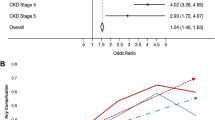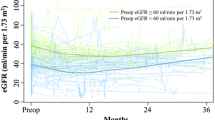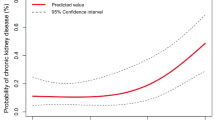Abstract
In recent years, research has questioned the theorized renal-protective value of mannitol infusion during partial nephrectomy. This study considers whether the cessation of routine mannitol administration has shown any benefit or detriment to patients in the contemporary era. We retrospectively reviewed a multi-institution database for an association between mannitol administration and subsequent renal function during follow-up. These patients were assessed for de novo stage III chronic kidney disease (CKD III) and followed with estimated glomerular filtration rate (eGFR). Statistical analysis included Mann–Whitney-U and Chi-squared tests for comparing baseline and perioperative variables with postoperative outcomes. eGFR changes were evaluated with a mixed-effects linear regression model. Nine hundred and fifteen patients were identified whose operative reports or surgeons’ treatment algorithms explicitly described whether or not mannitol was administered. 667 (73%) did not receive mannitol. There were no differences in demographics, age, Charlson comorbidity index, nephrometry score, tumor size, grading, or baseline eGFR from those who received mannitol. Ischemia time and operative time appeared slightly longer with mannitol use. Patients were followed for a median of 5 months (IQR 0.5–19 months), during which mannitol use was associated with an increase in de novo CKD III (14% v. 9%, p = 0.041) and minimally worsened median eGFR on final follow-up (72.82 v. 76.06, p = 0.039). Our analysis of partial nephrectomy patients indicates that mannitol administration likely confers no short- or long-term renal benefit. Mannitol may be used at the surgeon's discretion, but if it prolongs surgery time or ischemia time, it may in fact be detrimental to outcomes.
Similar content being viewed by others
Abbreviations
- CKD III:
-
Stage III chronic kidney disease
- eGFR:
-
Estimated glomerular filtration rate
References
Campbell S et al (2017) Renal mass and localized renal cancer: AUA guideline. J Urol 198(3):520–529
Cosentino M et al (2013) The use of mannitol in partial and live donor nephrectomy: an international survey. World J Urol 31(4):977–982
Rosen DC et al (2018) Reevaluating warm ischemia time as a predictor of renal function outcomes after robotic partial nephrectomy. Urology 120:156–161
Shah PH, Leibovich BC, Lyon TD (2018) Should urologists abandon the use of mannitol during partial nephrectomy? Eur Urol 73(1):60–61
Znaor A et al (2015) International variations and trends in renal cell carcinoma incidence and mortality. Eur Urol 67(3):519–530
Cooper CA et al (2018) Intraoperative mannitol not essential during partial nephrectomy. J Endourol 32(4):354–358
Spaliviero M et al (2018) Intravenous mannitol versus placebo during partial nephrectomy in patients with normal kidney function: a double-blind, clinically-integrated. Randomized Trial Eur Urol 73(1):53–59
Levey AS et al (2009) A new equation to estimate glomerular filtration rate. Ann Intern Med 150(9):604–612
Better OS et al (1997) Mannitol therapy revisited (1940–1997). Kidney Int 52(4):886–894
Schrier RW et al (1984) Protection of mitochondrial function by mannitol in ischemic acute renal failure. Am J Physiol 247(2 Pt 2):F365–F369
Morris CR et al (1972) Restoration and maintenance of glomerular filtration by mannitol during hypoperfusion of the kidney. J Clin Invest 51(6):1555–1564
Volpe A et al (2015) Renal ischemia and function after partial nephrectomy: a collaborative review of the literature. Eur Urol 68(1):61–74
Power NE et al (2012) Intraoperative mannitol use does not improve long-term renal function outcomes after minimally invasive partial nephrectomy. Urology 79(4):821–825
Omae K et al (2014) Mannitol has no impact on renal function after open partial nephrectomy in solitary kidneys. Int J Urol 21(2):200–203
Shawkat HWM, Mortimer A (2012) Mannitol: a review of its clinical uses. Contin Educ Anaesth Crit Care Pain 12:82–85
Gelman S (1996) Does mannitol save the kidney? Anesth Analg 82(5):899–901
Redfors B et al (2009) Effects of mannitol alone and mannitol plus furosemide on renal oxygen consumption, blood flow and glomerular filtration after cardiac surgery. Intensive Care Med 35(1):115–122
Bolte SL et al (2006) Maintaining urine production and early allograft function during laparoscopic donor nephrectomy. Urology 68(4):747–750
O’Dair J et al (2005) Routine use of renal-dose dopamine during living donor nephrectomy has no beneficial effect to either donor or recipient. Transplant Proc 37(2):637–639
Pérez J et al (2002) Role of dopamine in renal dysfunction during laparoscopic surgery. Surg Endosc 16(9):1297–1301
Funding
None.
Author information
Authors and Affiliations
Contributions
AB, KB, KEO and GW contributed to the study conception and design. Material preparation and data collection were performed by GW, JW, TD, KEO, EA and VW. Analysis was performed by KEO and TD. The first draft of the manuscript was written by GW, JW, TD, KEO, EA, VW and all authors commented on previous versions of the manuscript. All authors read and approved the final manuscript.
Corresponding author
Ethics declarations
Conflict of interest
George Wayne, Jeffrey Wei, Timothy Demus, Kennedy Okhawere, Elias Atri, Vivian Wong, Ketan Badani, and Akshay Bhandari declare that they have no conflict of interest. The authors declare that the research was conducted in the absence of any commercial or financial relationships that could be construed as a potential conflict of interest.
Ethics approval
The study was performed in accordance with the ethical standards of the responsible committee on human experimentation (institutional and national) and with the Helsinki Declaration of 1975, as revised in 2000. Data collection was IRB approved.
Consent to participate
All procedures followed were in accordance with the ethical standards of the responsible committee on human experimentation (institutional and national) and with the Helsinki Declaration of 1975, as revised in 2000. Informed consent was not obtained given the retrospective review design of this study.
Additional information
Publisher's Note
Springer Nature remains neutral with regard to jurisdictional claims in published maps and institutional affiliations.
Rights and permissions
About this article
Cite this article
Wayne, G., Wei, J., Demus, T. et al. Moving away from mannitol infusion for partial nephrectomy: has this altered renal function?. J Robotic Surg 17, 43–48 (2023). https://doi.org/10.1007/s11701-022-01397-7
Received:
Accepted:
Published:
Issue Date:
DOI: https://doi.org/10.1007/s11701-022-01397-7




